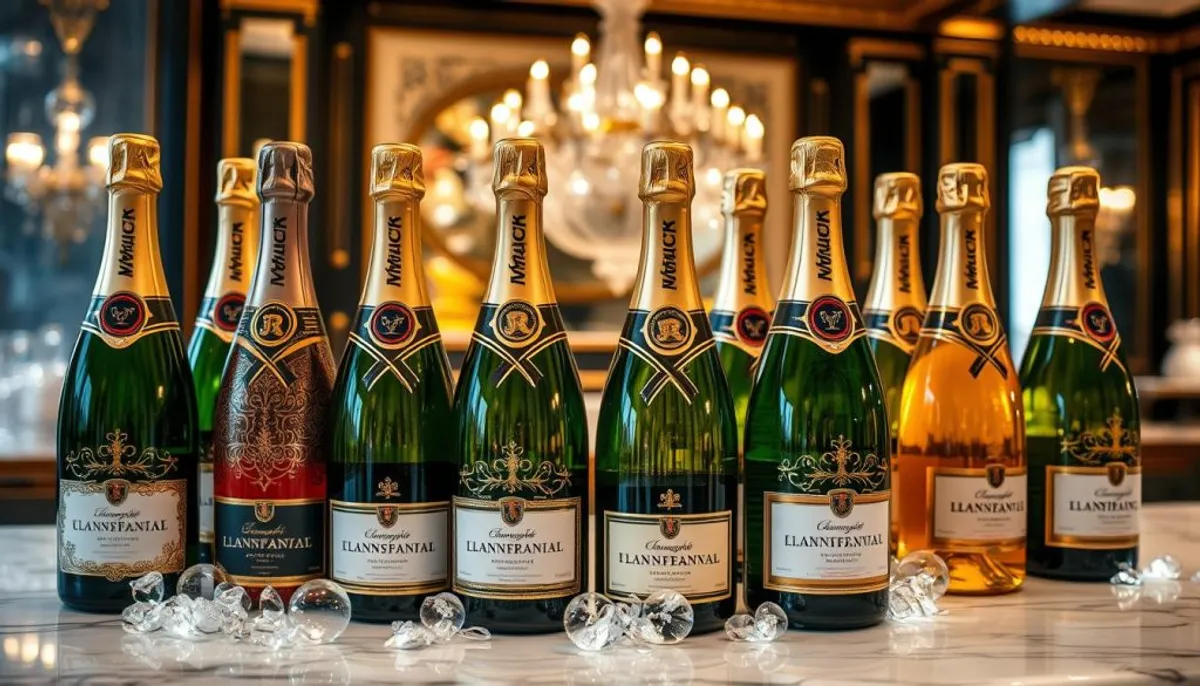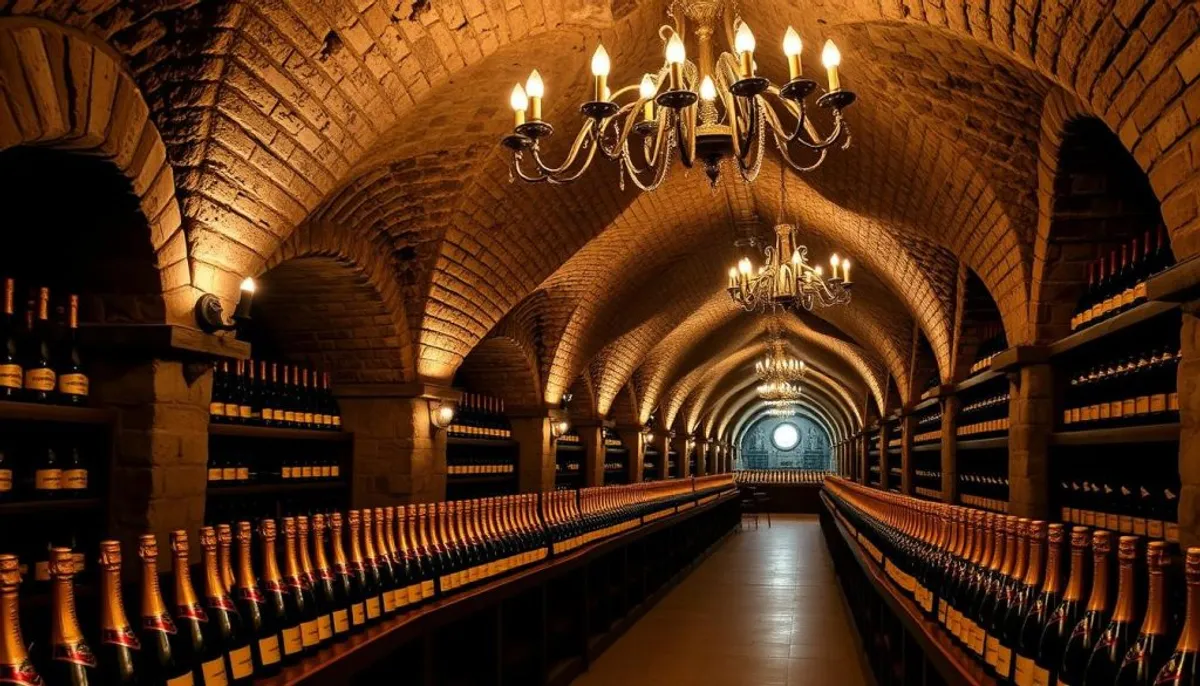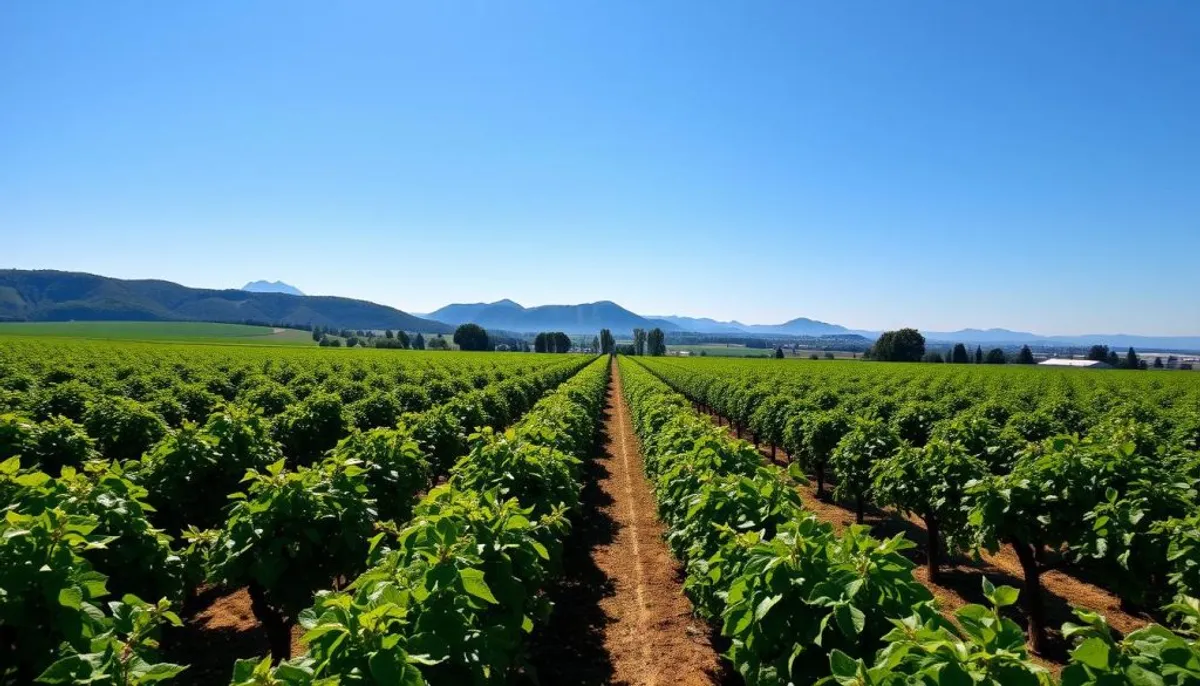In the heart of north-eastern France, the Champagne region invites with its picturesque hills and verdant vineyards. This UNESCO World Heritage site, merely 90 minutes from Paris by car, is the cradle of luxury champagne. Spanning 34,500 hectares, the vineyards here produce each bottle as a legacy of centuries-old traditions.

The capital, Epernay, is home to 110 kilometers of subterranean cellars where French bubbly matures to its finest. In Reims, 140 km from Paris, iconic houses like Moët & Chandon and Perrier-Jouët welcome visitors. These tours unveil the intricate craftsmanship behind every celebratory drink.
The Royal Champagne Hotel & Spa, a 5-star retreat, offers 47 rooms and suites. It boasts a Michelin-starred restaurant and a spa with 9 treatment rooms. This is the perfect setting to savor the region’s sparkling delights.
Key Takeaways
- Champagne is a UNESCO World Heritage site with over 34,500 hectares of vineyards
- Epernay’s underground cellars stretch for 110 kilometers
- Reims, 140 km from Paris, is home to world-renowned champagne houses
- The Royal Champagne Hotel & Spa offers luxury accommodations and a Michelin-starred restaurant
- Wine tourism in Champagne combines tasting with regional exploration
The Heritage of Champagne: A Journey Through Time
Champagne’s storied past is intricately woven into the fabric of French wine heritage. Its evolution has profoundly influenced the region’s culture and economy over the centuries.
Origins in North-Eastern France
The narrative of Champagne commences in the chalky terrains of north-eastern France. This distinctive terroir, marked by its chalky subsoil, is ideal for cultivating the grapes essential to Champagne production. The area’s mosaic of diverse terroirs encompasses the Montagne de Reims, celebrated for its Pinot Noir grapes, the Côte des Blancs, renowned for Chardonnay vineyards, and the Vallée de la Marne, where Pinot Meunier thrives.
Evolution of Champagne Making
The méthode champenoise, Champagne’s traditional production method, entails a secondary fermentation within the bottle. This technique, refined over time, is responsible for the wine’s characteristic bubbles and intricate flavors. The maturation of Champagne, a process that can span years for the finest vintages, exemplifies the commitment and patience inherent in its creation.
Historical Significance in French Culture
For centuries, Champagne has been a cornerstone of French culture. It transcends its role as a beverage, embodying celebration and opulence. The region hosts significant events, such as the Habits de Lumière in Épernay and the Champagne and You festival in the Côte des Blancs, underscoring its cultural significance. The Regional Natural Park of the Montagne de Reims invites visitors to discover the area’s natural splendor, with trails that weave through forests and vineyards, fostering a connection to the land that nurtures this iconic sparkling wine.
Understanding Majestic Champagne Production
Champagne production is an intricate art, deeply rooted in tradition and precision. Since the late 1600s, this process has undergone significant transformations. Initially, it focused on sweet styles, evolving into the dry wines we cherish today. This evolution in taste preferences has profoundly influenced modern Champagne making techniques.
Traditional Methods and Techniques
The core of Champagne production is the Traditional Method, also known as Méthode Traditionnelle. This method encompasses several critical steps:
- Careful grape harvesting and must extraction
- Primary fermentation followed by blending
- Secondary fermentation in the bottle
- Aging on lees for at least 12 months
- Riddling to collect sediment
- Disgorgement and dosage
The Role of Terroir
Terroir is pivotal in defining Champagne’s essence. The unique soil composition and climate of the Champagne region significantly influence the wine’s flavor profile. For example, Moussé Fils cultivates Meunier on a rare green clay terroir, resulting in exceptional single-vineyard Champagnes.
From Grape to Glass Process
The journey from grape to glass showcases the winemaking techniques integral to Champagne production. It commences in the vineyard and culminates in the final maturation in cool cellars. During this phase, dead yeast cells release substances that enrich the wine’s aroma and flavor. This contributes to its complexity and age-worthiness.
| Production Step | Duration | Impact on Wine |
|---|---|---|
| Harvesting | 2-3 weeks | Determines grape quality |
| Primary Fermentation | 1-2 weeks | Creates base wine |
| Aging on Lees | 12+ months | Develops complexity |
| Riddling | 1-2 months | Clarifies wine |
| Final Maturation | Varies | Refines flavors |
The Grand Houses of Reims
Reims, the epicenter of Champagne, is home to some of the world’s most revered wineries. The city’s Champagne houses are a testament to history, artistry, and luxury. Each visit is a journey through centuries of winemaking tradition, from the depths of cellars to the opulence of tasting rooms.
Reims Champagne houses are more than just producers of sparkling wine. They are custodians of heritage, with many cellars and structures recognized as UNESCO World Heritage sites. The Cathedral of Notre-Dame in Reims, for example, stands as a symbol of the region’s storied past.
Champagne tours in Reims cater to a wide range of preferences and budgets. Prices vary from 10€ to 210€ per guest, offering everything from basic tastings to exclusive cellar visits, as well as outdoor living solutions for those who wish to enjoy their experience in a more relaxed setting. The average rating for these tours is a remarkable 4.4 to 4.9, reflecting high visitor satisfaction.
| Champagne House | Unique Feature | Average Rating |
|---|---|---|
| Pommery | Sensory center in historic press house | 4.6 |
| Veuve Clicquot | Worldwide welcome for amateurs | 4.7 |
| Taittinger | Cellars reopening after restoration (2024) | 4.8 |
| Mumm | 25 million bottles in cellars | 4.5 |
| Lanson | Vine-to-flute visit experience | 4.9 |
Each of these esteemed wineries offers a unique window into the world of Champagne. Whether you’re captivated by Pommery’s innovative sensory center or Mumm’s vast cellars, Reims Champagne houses promise unforgettable experiences. They are a must-visit for wine aficionados and curious travelers alike.
Exploring Pommery’s Neo-Elizabethan Marvel
Pommery Champagne is a symbol of opulence in Reims’ heart. Founded in 1858, it showcases a 19th-century neo-Elizabethan architectural wonder. This marvel attracts visitors from all corners of the globe.
18 Kilometers of Historic Cellars
The true gem of Pommery lies beneath the earth. An extensive network of historic cellars, spanning 18 kilometers, is carved into chalk bedrock. These subterranean tunnels provide the ideal environment for aging Pommery’s celebrated Brut Royal and other champagnes.

UNESCO Heritage Recognition
Pommery’s cellars hold more than just champagne. They are a UNESCO World Heritage site, embodying France’s cultural heritage. Visitors can wander through this underground world, admiring the detailed chalk carvings and ancient bottles.
Signature Tasting Experiences
Every visit to Pommery culminates in its signature tasting experiences. Connoisseurs can delight in the complex flavors of Pommery’s top champagnes, gaining insights into champagne craftsmanship. Daily tours cater to all tastes, offering both self-guided and expert-led options.
| Tour Type | Price | Duration |
|---|---|---|
| Self-Guided | €26 | 1 hour |
| Guided Experience | €32 | 1.5 hours |
| Premium Tasting | €45 | 2 hours |
Veuve Clicquot: A Legacy of Excellence
Veuve Clicquot Champagne epitomizes luxury, tracing its roots back to 1805. Barbe Nicole Clicquot Ponsardin, a pioneering woman, transformed her late husband’s wine business. She introduced the first vintage Champagne in 1810 and the first blended Rosé Champagne in 1818.
The iconic yellow label, introduced in 1877, has become a symbol of premium Champagne globally. Veuve Clicquot’s commitment to excellence is reflected in its extensive vineyards. These cover over 280 hectares across Champagne’s most revered regions.
Visitors can explore the brand’s historic wine cellars through various tour options. These immersive experiences range from half-day excursions with vineyard stops and triple tasting sessions. Full-day tours combine visits to other prestigious houses like Moët & Chandon.
Veuve Clicquot’s commitment to innovation continues today. The brand recently unveiled a pop-up gastronomic concept in Zurich, showcasing their Yellow Label Champagne. Their premium cuvée, La Grande Dame 2015, boasts at least 90% Pinot Noir. It has an impressive aging potential of over 15 years.
For a truly unique experience, Veuve Clicquot collaborates with Michelin-starred Chef Dario Cadonau at the IN LAIN Hotel Cadonau in Switzerland. This exclusive venue houses one of Europe’s largest Veuve Clicquot cellars. It offers guests an unparalleled journey into the world of luxury bubbly.
Taittinger’s Ancient Chalk Pits and Modern Appeal
Taittinger Champagne is a symbol of the Champagne region’s storied past. Founded by Pierre Taittinger, this esteemed house traces its lineage back to the 13th century. Today, Vitalie Taittinger, Pierre’s great-granddaughter, presides over the family enterprise as its president.
13th Century Origins
The cellars of Taittinger are situated 18 meters beneath the Abbey of Saint-Nicaise. These ancient chalk pits, excavated in the 4th century, offer an ideal environment for aging champagne. The unique subterranean setting is a key factor in the superior quality of Taittinger’s champagnes.
Art Collections and Cellar Tours
Guests at Taittinger are invited to discover the captivating realm of champagne production through guided cellar tours. These tours unveil the house’s art collections and the meticulous craftsmanship behind fine champagne. It offers a unique insight into Taittinger’s dedication to quality and tradition.
Signature Cuvées
Taittinger’s repertoire includes a variety of signature cuvées, each a testament to the house’s mastery. The limited vineyard area in the Champagne region, priced at €1 million per acre, highlights the exclusivity of these wines. Every bottle, from the classic bruts to the prestigious vintages, reflects Taittinger’s unwavering commitment to excellence.
| Taittinger Fact | Detail |
|---|---|
| Cellar Depth | 18 meters underground |
| Cellar Location | Abbey of Saint-Nicaise |
| Chalk Pit Origin | 4th century |
| Vineyard Value | €1 million per acre |
| UNESCO Recognition | Champagne region designated in 2015 |
The Dom Pérignon Experience in Hautvillers
Hautvillers, situated at the heart of France’s Champagne region, is a village of unparalleled significance in the luxury wine world. It is the origin of Dom Pérignon Champagne, a brand that epitomizes excellence and innovation in winemaking.
The narrative of Dom Pérignon commences at the historic Hautvillers Abbey. In the late 17th century, Dom Pérignon, a monk, held the position of cellar master. His pioneering work in fermentation, bottle design, and blending techniques transformed Champagne production, elevating it to unparalleled levels of quality and prestige.
Today, connoisseurs can embark on a luxury wine tasting adventure at the Abbey. Visitors have the opportunity to explore the cellars where Dom Pérignon refined his craft. They gain insight into the rich history and meticulous processes behind this iconic Champagne.
| Experience | Description |
|---|---|
| Cellar Tour | Explore the historic cellars of Hautvillers Abbey |
| Vineyard Walk | Stroll through picturesque vineyards surrounding the Abbey |
| Tasting Session | Sample exquisite Dom Pérignon vintages |
| Historical Presentation | Learn about Dom Pérignon’s life and innovations |
The Dom Pérignon experience in Hautvillers transcends mere tasting. It is a journey through time, connecting visitors to Champagne’s heritage. From the Abbey’s ancient stones to the bubbles in your glass, every moment is steeped in centuries of craftsmanship and passion.
Louis Roederer: Precision in Every Pour
Louis Roederer Champagne is a paragon of excellence in the sparkling wine realm. Established in 1776, this family-owned winery has upheld its independence and dedication to quality for over two centuries. Currently, Frédéric Rouzaud, the 7th generation of the Roederer family, serves as the CEO.

Premium Vineyards: The Foundation of Excellence
The cornerstone of Louis Roederer’s triumph is its 240 hectares of premium vineyards. These meticulously tended plots are situated exclusively in Grands and Premiers Crus villages. This extensive estate enables the house to be self-sufficient for 70% of their non-vintage production and 100% of their vintage champagnes.
Tradition Meets Innovation
Louis Roederer harmoniously merges tradition with cutting-edge winemaking techniques. Since 2000, the house has adopted organic and biodynamic viticulture. All vineyards now adhere to organic principles, with half certified organic and the remainder farmed biodynamically. This commitment to sustainable practices elevates the quality and distinctiveness of their champagnes.
The winery’s dedication to innovation is also reflected in its facilities. A new tasting room features a striking horseshoe-shaped bar, crafted from HIMACS material. This bar, with its blend of white, greige, and gold hues, mirrors the Roederer monogram, embodying the fusion of tradition and modernity that defines Louis Roederer Champagne.
| Champagne | Blend | Notable Features |
|---|---|---|
| Brut Premier | 40% Pinot Noir, 40% Chardonnay, 20% Meunier | Blended from six vintages, over 40 plots |
| Cristal | 55% Pinot Noir, 45% Chardonnay | From best Grand Cru sites, 2008 vintage scored 100 points |
| Brut Nature | Varies | Zero dosage, from biodynamic Premier Cru village |
Mumm: A Journey Through Sparkling Excellence
Maison Mumm invites you to explore the world of sparkling excellence in Reims. The historic cellars of this renowned Champagne house offer a glimpse into centuries of winemaking tradition. Visitors can uncover the secrets behind Mumm’s iconic bottles and savor the essence of luxury cuvées.
For €28, guests embark on a guided tour through Mumm’s underground labyrinth. These tours reveal the meticulous process of crafting Mumm Champagne, from vine selection to the final pour. The journey showcases the house’s dedication to quality and innovation in every step of production.
One of Mumm’s standout offerings is the Mumm de Cramant. This 100% Chardonnay Brut champagne boasts a CLB score of 92. Aged for six years and featuring a dosage of 6g, it exemplifies the house’s commitment to excellence. The Mumm de Cramant, priced between €45-55, represents the perfect blend of tradition and modern winemaking techniques.
Under the guidance of Chef de Caves Laurent Fresnet, Mumm continues to push boundaries. The house employs the unique “crémant de Cramant” method, producing champagne with 4.5Kg pressure at 10ºC. This approach results in a refined, elegant sparkler that captivates connoisseurs and casual drinkers alike.
A visit to Mumm offers more than just a tasting experience. It’s an immersive journey into the art and science of champagne production, set against the backdrop of Reims’ rich cultural heritage. Whether you’re a champagne enthusiast or a curious traveler, Mumm’s cellars promise an unforgettable exploration of sparkling excellence.
Ruinart: The Oldest Champagne House
Ruinart Champagne, established in 1729, is the oldest Champagne house, boasting a history of nearly 300 years. Located in Reims, northeastern France, it recently reopened after a three-year renovation. This transformation showcases a harmonious blend of tradition and modern luxury.
Ancient Cellar Architecture
The historic chalk pits and cellars of Ruinart are UNESCO World Heritage sites. They offer a unique insight into centuries of winemaking tradition. These cellars, carved into the chalk, create an ideal environment for aging Champagne.
The newly renovated Nicolas Ruinart Pavilion, designed by Japanese architect Sou Fujimoto, brings a contemporary touch to the ancient grounds.
Blending and Aging Mastery
Ruinart’s commitment to quality winemaking is evident in their meticulous processes. They employ soft and progressive juice extraction to enhance flavor profiles. Chardonnay, sourced mainly from the Côte des Blancs and Montagne de Reims regions, is crucial in their cuvées. These are known for their minerality, elegance, and lightness.
The house offers exclusive cellar tours, allowing visitors to explore over 75,000 square feet of grounds. This includes 55,000 square feet of woodlands. Art enthusiasts will find 110 pieces from 36 artists displayed across the venue, with 19 original works in the sculpture garden.
Ruinart Champagne continues to innovate while honoring its heritage. They offer Blanc de Blanc, Rosé, and R de Ruinart cuvées. Their commitment to sustainable viticulture practices demonstrates a proactive stance against global warming. This ensures the legacy of this oldest Champagne house for generations to come.
Expert Tips for Champagne Tasting and Storage
Enhancing your appreciation for champagne involves mastering the art of tasting and storage. A comprehensive guide to champagne tasting begins with serving the wine at 6°C. This temperature is crucial. The ideal glass for champagne has a pointed bottom that widens towards the top. This design helps preserve bubbles and aromas, enriching your tasting experience.
Proper storage of champagne is equally important. Store bottles in a dark environment with a consistent temperature between 10 and 14°C. Maintaining 80% atmospheric humidity is also key. These conditions ensure your champagne remains in its best state for future enjoyment.
To achieve the ultimate champagne tasting experience, consider a Magnum bottle. This 1.5-liter size, equivalent to two standard bottles, is perfect for preserving flavors and aromas. It’s worth noting that champagne corks can pop out at speeds up to 62 miles per hour. So, be cautious when opening your bottle.
| Aspect | Recommendation |
|---|---|
| Serving Temperature | 6°C |
| Storage Temperature | 10-14°C |
| Humidity | 80% |
| Ideal Bottle Size | Magnum (1.5L) |
| Glass Shape | Pointed bottom, broadening top |
By adhering to these expert tips, you will significantly improve your champagne tasting abilities and ensure the proper storage of your cherished bottles. Cheers to your enhanced appreciation for bubbly!
Conclusion
The Champagne region is a pinnacle of French wine tourism, presenting a luxury Champagne experience unmatched elsewhere. From Maison Ruinart’s historic cellars to Veuve Clicquot’s vast underground networks, each visit is a time-traveling journey through taste. These esteemed houses, recognized by UNESCO, highlight the profound heritage and craftsmanship in every bottle.
Exploring the Champagne region transcends simple tasting. It’s a dive into a realm where tradition and innovation converge. The region’s dedication to maintaining traditional skills while adopting cutting-edge methods, such as Winewizard’s smart micro-oxygenation, guarantees each sip is a tribute to centuries of expertise and innovation.
Embarking on a French wine tourism journey, remember the Champagne region offers more than just effervescence. It’s a confluence of history, culture, and cuisine. Whether you’re delving into Ruinart’s 38-meter deep cellars or admiring Veuve Clicquot’s 24-kilometer network, you’re engaging with a legacy that enthralls wine aficionados globally. This extraordinary beverage encapsulates celebration and elegance in every glass.
RelatedRelated articles



